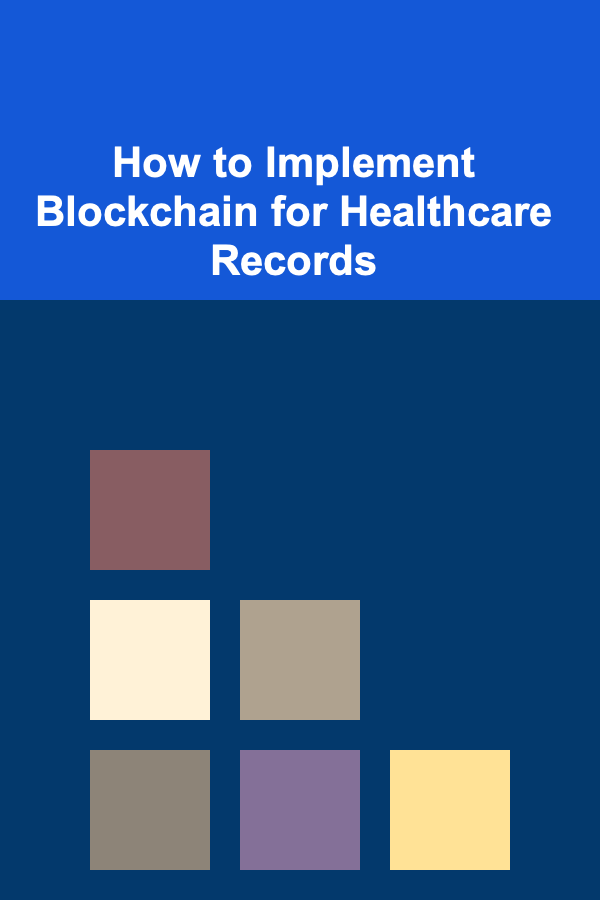
How to Implement Blockchain for Healthcare Records
ebook include PDF & Audio bundle (Micro Guide)
$12.99$10.99
Limited Time Offer! Order within the next:

The healthcare industry is evolving at a rapid pace, driven by advancements in technology and a growing demand for efficient, secure, and transparent systems. One such breakthrough technology is blockchain, which has garnered attention for its ability to address several challenges faced by the healthcare sector, particularly in the management and security of healthcare records.
Healthcare records are critical to the overall well-being of patients, serving as the foundation for diagnosis, treatment, and ongoing care. However, traditional systems for managing these records are plagued with issues such as data fragmentation, lack of interoperability, security vulnerabilities, and privacy concerns. Blockchain, with its decentralized, immutable, and transparent nature, presents a compelling solution to these problems.
This article delves into how blockchain can be implemented in healthcare records management, exploring its benefits, challenges, and practical steps for adoption. By examining the potential of blockchain in transforming healthcare data management, this piece will provide insights into how this revolutionary technology can improve patient care, streamline healthcare processes, and ensure greater security and privacy.
Understanding Blockchain and Its Relevance to Healthcare
Blockchain is a distributed ledger technology that securely records transactions across multiple computers in a way that prevents the alteration of records. The core characteristics of blockchain---decentralization, immutability, and transparency---make it particularly valuable for industries that rely on data integrity, security, and trust.
In the context of healthcare, blockchain can provide a decentralized network for storing and sharing patient data, ensuring that all transactions are recorded in a tamper-proof manner. Each participant in the network, such as healthcare providers, patients, insurers, and other stakeholders, can have a unique identifier on the blockchain, and they can access or update the records in a secure and auditable way.
Key Features of Blockchain for Healthcare Records
- Decentralization: Traditional healthcare records are typically stored in centralized databases, creating vulnerabilities for hacking or data breaches. Blockchain's decentralized nature means that there is no single point of failure, making it far more resilient to attacks.
- Immutability: Once data is entered into a blockchain, it cannot be altered or deleted without consensus from the network. This ensures that healthcare records are permanent and tamper-proof, making them reliable and trustworthy.
- Transparency and Auditability: Blockchain provides a transparent system where every transaction is recorded and can be audited by authorized participants. This feature ensures that healthcare professionals can track the history of medical records and verify their authenticity.
- Privacy and Security: Blockchain allows for the encryption of data, ensuring that sensitive patient information remains confidential while still being accessible to authorized parties. With blockchain, healthcare providers can manage consent and access control to ensure that only relevant stakeholders have access to a patient's medical records.
- Interoperability: One of the key issues in healthcare is the lack of interoperability between different systems and healthcare providers. Blockchain can enable seamless sharing of healthcare records across various platforms, ensuring that all parties involved in a patient's care have access to up-to-date and accurate information.
The Challenges in Implementing Blockchain for Healthcare
While the potential of blockchain in healthcare is vast, its implementation is not without challenges. The healthcare sector is highly regulated, and introducing new technologies requires careful consideration of existing laws, standards, and infrastructure. Below are some of the main challenges that need to be addressed:
1. Regulatory and Legal Compliance
The healthcare industry is heavily regulated, with strict rules around patient data privacy and security. For example, in the United States, the Health Insurance Portability and Accountability Act (HIPAA) mandates the confidentiality and security of patient health information. Implementing blockchain in healthcare must comply with these regulations, which can be a complex and time-consuming process.
Blockchain's decentralized nature also raises questions about data ownership and access. Legal frameworks must be adapted to account for the fact that data is not stored in a single location but rather across multiple nodes in a network. This can make it difficult to determine who is responsible for maintaining and securing the data.
2. Data Privacy and Consent Management
Healthcare data is extremely sensitive, and patients must have control over who accesses their information. Blockchain can help improve data privacy by allowing patients to manage access to their records through smart contracts and cryptographic keys. However, the challenge lies in ensuring that only authorized parties can access this data while maintaining patient consent.
Additionally, healthcare data may need to be updated frequently, which raises concerns about the immutability of blockchain. While immutability ensures that data cannot be tampered with, it also means that any updates or corrections to a patient's medical record could be difficult to manage. This may present challenges when patients want to correct or update their medical history.
3. Interoperability with Existing Systems
Many healthcare organizations already use electronic health record (EHR) systems, which are often siloed and lack interoperability with one another. Integrating blockchain into these existing systems requires careful planning and coordination to ensure seamless communication between platforms. Healthcare providers may need to invest in new infrastructure and training to enable blockchain adoption, which could be costly and time-consuming.
Additionally, the adoption of blockchain requires a cultural shift within healthcare organizations. Healthcare professionals must be willing to embrace a new way of managing and sharing patient data, which may require changes to workflows, data management practices, and communication processes.
4. Scalability and Performance
Blockchain networks can face performance issues when dealing with large volumes of data. In healthcare, records can be vast, covering everything from patient demographics to medical histories, lab results, prescriptions, and billing information. Processing this data in a timely manner across a decentralized network can be challenging.
Blockchain solutions must be scalable to handle the high volume of transactions that occur in a healthcare setting. The use of permissioned blockchains, where only authorized participants can validate transactions, can help improve performance, but this adds another layer of complexity to the implementation process.
5. Adoption and Integration Costs
The implementation of blockchain in healthcare requires a significant upfront investment in technology and training. Healthcare organizations must assess whether the benefits of blockchain, such as improved security, transparency, and patient care, justify the costs of adoption.
For small healthcare providers or organizations with limited resources, the costs of integrating blockchain could be prohibitive. As with any new technology, widespread adoption will require time and resources, as well as the involvement of various stakeholders, including healthcare providers, insurers, patients, and technology vendors.
Steps to Implement Blockchain for Healthcare Records
Despite the challenges, blockchain presents a promising solution for improving the management of healthcare records. The following steps outline a framework for implementing blockchain in healthcare:
1. Assess the Need for Blockchain
The first step in implementing blockchain in healthcare is to assess whether blockchain is the right solution for the specific challenges faced by the organization. This involves conducting a thorough analysis of existing systems, identifying inefficiencies, and evaluating whether blockchain can address these issues.
Key areas where blockchain can add value include improving data security, streamlining administrative processes, enhancing patient care coordination, and increasing transparency in billing and claims management.
2. Design the Blockchain Network
The next step is to design the blockchain network, taking into account factors such as data privacy, scalability, and interoperability with existing systems. Healthcare organizations must decide whether to use a public, private, or permissioned blockchain. Public blockchains are fully decentralized, while private blockchains are more centralized, and permissioned blockchains offer a hybrid approach with restricted access.
Healthcare organizations must also choose the appropriate consensus mechanism for the blockchain network. Common consensus mechanisms include Proof of Work (PoW), Proof of Stake (PoS), and Practical Byzantine Fault Tolerance (PBFT). The choice of consensus mechanism will affect the scalability, security, and performance of the blockchain network.
3. Integrate with Existing Healthcare Systems
To ensure that blockchain works seamlessly with existing healthcare systems, it is important to design APIs (application programming interfaces) that facilitate integration with electronic health record (EHR) systems, laboratory information systems (LIS), and other healthcare platforms.
This step also involves creating standardized protocols for data sharing and ensuring that data stored on the blockchain can be easily accessed by authorized parties, such as healthcare providers and patients.
4. Ensure Compliance with Legal and Regulatory Requirements
Before deploying blockchain for healthcare records, organizations must ensure compliance with relevant regulations, such as HIPAA in the U.S. or GDPR in the European Union. This may involve working with legal teams to review contracts, obtain patient consent, and ensure that the blockchain implementation complies with privacy and security laws.
5. Implement and Test the System
Once the blockchain network is designed and integrated, it is time to implement and test the system. This phase involves running pilot programs to ensure that the blockchain network functions as expected, and that it can handle the demands of real-world healthcare data.
Testing should also include user acceptance testing (UAT), where healthcare professionals and patients interact with the system to provide feedback on its usability, security, and functionality.
6. Train Healthcare Providers and Staff
The success of a blockchain implementation depends on the willingness of healthcare providers and staff to embrace the new technology. Organizations should invest in training programs to ensure that all stakeholders are familiar with blockchain and its benefits. Training should cover how to access and update patient records, manage consent, and understand the security features of the blockchain.
7. Monitor and Optimize the System
After the blockchain system is deployed, ongoing monitoring and optimization are essential. Healthcare organizations should track the performance of the system, gather feedback from users, and identify areas for improvement. Regular updates and optimizations will help ensure that the system remains secure, scalable, and efficient.
Conclusion
Blockchain holds significant promise for transforming the management of healthcare records, offering enhanced security, transparency, and interoperability. However, implementing blockchain in healthcare requires careful consideration of regulatory requirements, data privacy concerns, interoperability challenges, and adoption costs.
By following a structured approach to assess needs, design the system, integrate with existing technologies, and ensure legal compliance, healthcare organizations can successfully implement blockchain for healthcare records. The result could be a more efficient, secure, and patient-centered healthcare system, paving the way for improved care, reduced costs, and greater trust among stakeholders.

How to Check and Maintain Your Home's Sewer System
Read More
How to Display Art and Photos Without Cluttering Walls
Read More
How to Make Your Own Holiday Wreath for the Front Door
Read More
How to Understand Blockchain Sidechains and Their Benefits
Read More
How To Prepare Your Home for a New Pet
Read More
How to Build Financial Models for Profit Projection
Read MoreOther Products

How to Check and Maintain Your Home's Sewer System
Read More
How to Display Art and Photos Without Cluttering Walls
Read More
How to Make Your Own Holiday Wreath for the Front Door
Read More
How to Understand Blockchain Sidechains and Their Benefits
Read More
How To Prepare Your Home for a New Pet
Read More